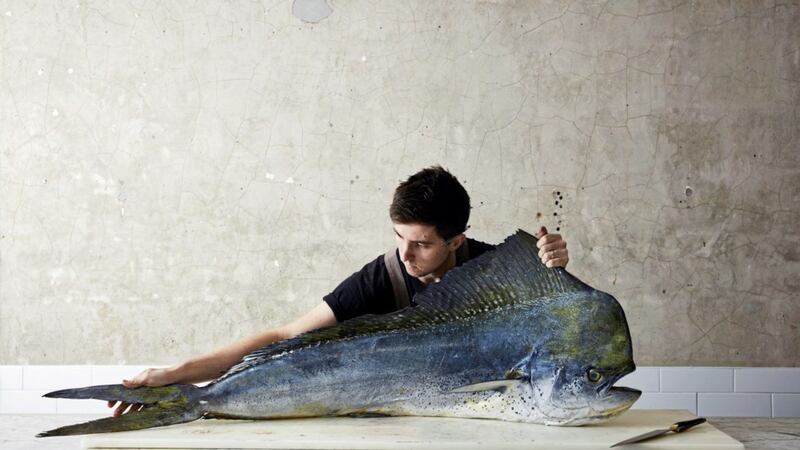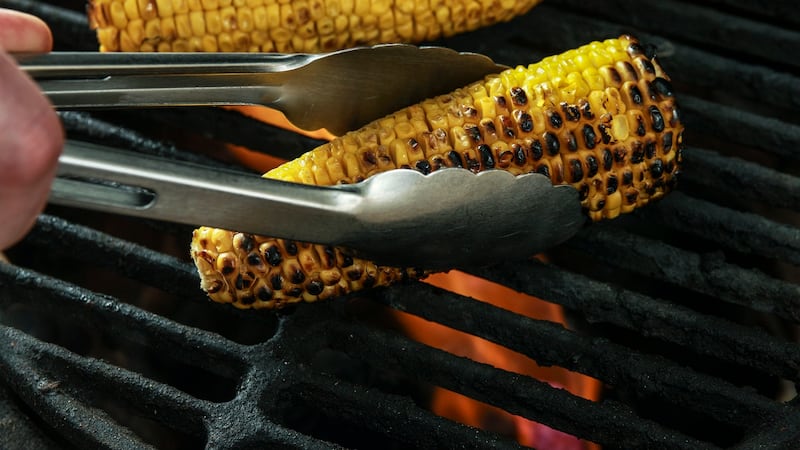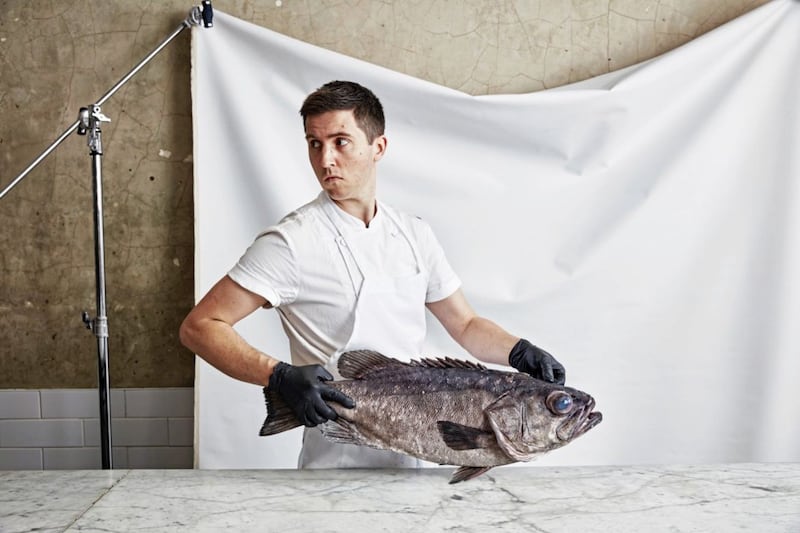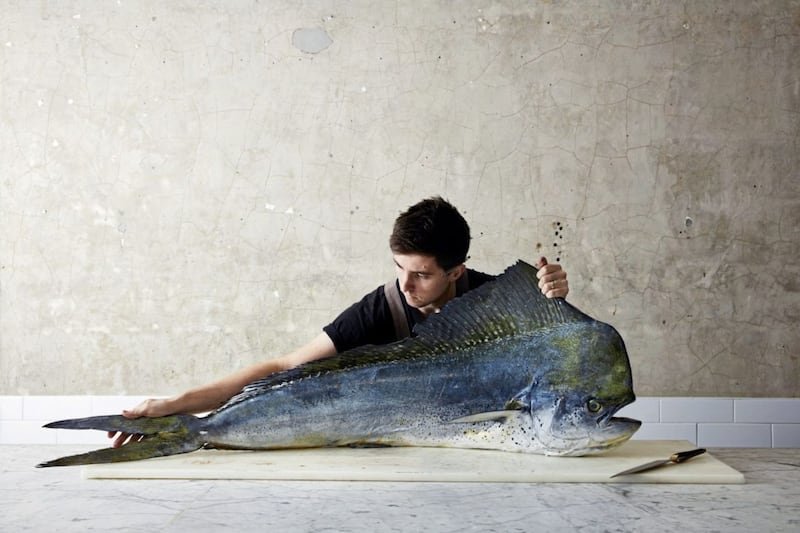OPEN Australian chef Josh Niland's new cookbook and you will see a literal representation of its title – a whole fish (a bass grouper), severed into its many edible, cookable parts. All 31 of them. There are, it turns out, far more parts of a fish that deserve a lick of heat and hit a of salt than you might think.
The Whole Fish Cookbook distils Niland's belief that we should treat fish cookery with the same confidence we do meat, in terms of the actual hob action as well as the butchery that comes first.
His aim is to arm us with some methods "beyond just pan frying", to diversify the kind of fish we're bringing home, and make us think about seafood a little differently.
Take a tuna cheek compared to a beef cheek. Sure, you'll cook them for different lengths of time, but, Niland notes, "you can braise a beef cheek in red wine, so why can't I do that with tuna? And why can't I serve it with mashed potatoes and a little onion and bacon and do a tuna cheek Bourguignon?"
The chef, who heads up celebrated seafood restaurant Saint Peter in Sydney, Australia, may be a seafood aficionado now, but by no means did he grow up on the beach. He recalls that a local river did cut through his town, though, and his mum would take him there every so often.
"We would make a dough out of flour, water and Vegemite, then we'd put it on a hook and literally throw it in and see what we could catch," he remembers, with a laugh. "I was always amused that we could catch stuff with such primitive bait."
His mum would show him how to gut the fish ("You wouldn't pull any of the pin bones out, that was too much work") before dusting it with flour and cooking it in a pan, spraying it with canola oil.
"It was not a luxe fish set up that I grew up with, but it was an understanding that you catch it, then you cook it and eat it." That respect for the fish is built into the methods and techniques he advocates for now.
"To buy a sweaty piece of salmon coming out of a little packet, I think, is doing a further disservice to the fish," he explains. "You're not getting a great sense of what the flavour of the fish is, you're just getting the omega-3s you're craving."
Instead, he is interested in 'fish-to-gill' cooking, dry handling (not rinsing fish under water), dry ageing and curing (like you would meat), and not always reaching to place a fillet in a pan.
"In my head, there is 91 per cent [eating] potential in a round fish," Niland explains. "Gone are the days when it used to be 40-50 per cent yield." His recipes (which are genuinely usable – "I haven't gone too geeky with cheffy stuff") and his menu, reflects that commitment to cutting waste and using every scrap of the catch, and so creating everything from fish black pudding to glazed fish throats and fried scales.
And while the squeamish may struggle initially, Niland already finds the first thing that sells out in his restaurant is fish offal.
"It is the most desired commodity on the menu, which is wonderful," he says with pride, and a certain amount of awe. He describes watching people come into his Fish Butchery – Australia's first sustainable fishmonger – and order his king fish sperm mortadella, which features king fish liver pate in a baguette with strands of carrots and spring onions, like a banh mi.
"They walk out eating it, and I'm just giggling to myself like, 'Wow, that's amazing, that's such a leap,'" he buzzes. "That's extraordinary to me, and I think that's because it comes with, not humour, but a gesture and a level of value, where we've managed to modify something previously perceived as icky and weird and slightly phallic, and turn it into something really ultimately delicious."
It works, he says, because however different the ingredients, it's still familiar to the eye. Hence why he'll joint fish to look like lamb cutlets and T-bone steaks – it helps assuage people's fish-related fears.
What he doesn't want to do is make people feel uncomfortable, "or belittled, as if, were you globally aware of food trends, you'd know better." And that goes for eating fish out, as well as preparing it at home.
One of the major problems is a lack of confidence, says Niland, especially when so many of us "get convinced by TV to take a whole fish home and give it a crack for the first time," even though "to go home with a whole fish is super intimidating for a novice cook." Going down that route means you'll almost certainly "end up with scales up the curtains".
The idea is, The Whole Fish will break things down, and build up your seafood confidence and technique as you work your way through it.
:: The Whole Fish Cookbook: New ways to cook, eat and drink by Josh Niland, published by Hardie Grant, priced £25. Photography Rob Palmer. Below are two recipes from the book for you to try.
CRUMBED SARDINE SANDWICH
(Serves 2)
150g plain flour
4 eggs, lightly whisked
120g white panko breadcrumbs
8 x 60g sardines, scaled, gutted and butterflied (or anchovies, herring or whiting)
70g ghee
Sea salt flakes and freshly cracked black pepper
4 slices soft white bread
100g yoghurt tartare sauce
Method:
Start by flouring, egg washing and crumbing the butterflied sardines, being sure to leave the tails of the fish uncrumbed.
Heat the ghee in a frying pan over a high heat and cook the crumbed sardines, in batches, on one side for one minute, or until golden and crisp, then flip to the other side and fry for a further 10-20 seconds. Remove from the pan and season liberally.
Cut the crusts off the bread. Spread some of the sauce over two of the slices of bread from edge to edge, then arrange four sardines on top. Add the remaining sauce on top and then the remaining slices of bread.
Serve with the golden edges of the sardine showing around the edges of the bread and the little tails exposed at one end.
SWEET AND SOUR ALBACORE, RADICCHIO AND HAZELNUTS
(Serves 6)
600g trimmed centre-cut albacore loin (alternatively mackerel or tuna)
60ml olive oil
1 head white radicchio, leaves torn into bite-sized pieces
Sea salt flakes and freshly cracked black pepper
3tbsp roasted hazelnuts
Sweet and sour currant sauce:
120ml extra virgin olive oil
150g French shallots, finely diced
150ml white wine
375ml white wine vinegar
150ml water
75g caster sugar
125g dried currants
Sea salt flakes and freshly cracked black pepper
Method:
Preheat the oven to the lowest possible temperature. For the sweet and sour sauce, heat the oil in a saucepan and sweat the shallots over a low heat for 15 minutes until just golden. Add the wine, vinegar, water, sugar, currants and a little salt and pepper and simmer briskly for four minutes, until the shallots are very tender and the sauce is thick and syrupy. You should have 225ml of sauce after the reduction. Cool and chill until needed.
Cut the fish you're using into even-sized quarter planks, then chill, uncovered, in the refrigerator.
Place a wire rack inside a baking tray to act as a trivet to cook the albacore on. Cut some baking paper to fit the size of the wire rack and, using a small knife, cut enough holes over the paper to allow the juices to strain through during cooking. Arrange the fish on the prepared wire rack and place in the oven. The oven should be between 90-100°C (194-212°F) throughout the cooking process. If you feel the oven is hotter than this then rest a pair of tongs or a wooden spoon in the door to hold the oven ajar. The internal temperature for the fish should be 40°C (104°F) when measured with a probe thermometer. Ideally, the fish should still look quite raw but with a gently cooked texture (be careful here as, unfortunately, albacore dries out very quickly during cooking).
Meanwhile, heat the olive oil in a frying pan over a high heat and saute the radicchio leaves. Season well with salt and, at the last minute when the leaves are blistered and lightly wilted, add the roast hazelnuts and four generous tablespoons of the sweet and sour sauce. Keep warm.
Leave the fish to rest briefly, then slice three slices per portion. Brush with olive oil, season with sea salt, cracked black pepper and drape over the sweet and sour radicchio and hazelnuts. Serve.




